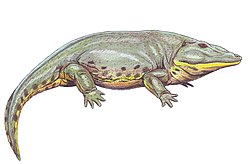| Cyclotosaurus buechneri Temporal range: Late Triassic, | |
|---|---|
 | |
| Holotype skull | |
| Scientific classification | |
| Kingdom: | Animalia |
| Phylum: | Chordata |
| Clade: | Tetrapoda |
| Order: | † Temnospondyli |
| Suborder: | † Stereospondyli |
| Clade: | † Capitosauria |
| Family: | † Mastodonsauridae |
| Genus: | † Cyclotosaurus |
| Species: | †C. buechneri |
| Binomial name | |
| †Cyclotosaurus buechneri Witzmann, Sachs & Nyhuis, 2016 | |
Cyclotosaurus buechneri is a species of the temnospondyl genus Cyclotosaurus from the Upper Triassic (middle Carnian) of northwestern Germany. [1]
Contents
The type and only known specimen is a 28 cm long skull that was found in 1975 by Martin Büchner, the former director of the Natural History Museum Bielefeld, at a construction site in Bielefeld-Sieker, Germany. The specimen derives from the Stuttgart Formation and is kept in the collection of the Natural History Museum in Bielefeld. In 2016, Florian Witzmann, Sven Sachs and Christian Nyhuis provided a detailed description of the skull and established the new species, Cyclotosaurus buechneri, honoring the discoverer.
Cyclotosaurus buechneri differs from other species of Cyclotosaurus e.g. by a narrower distance between the orbitae, a more slender postorbital region and a distinct shape of the jugal. It was nearly 2 meter long and is the only unequivocal evidence of a cyclotosaur in northern Germany. [1]



